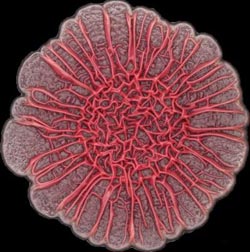Chips that listen to bacteria

The development of colony biofilms by Pseudomonas aeruginosa is affected by redox-active compounds called phenazines. A phenazine-null mutant forms a hyperwrinkled colony with prominent spokes, while wild-type colonies are more constrained and smooth.<br><br>Credit: Hassan Sakhtah, Columbia University<br>
In a study published today in Nature Communications, a research team led by Ken Shepard, professor of electrical engineering and biomedical engineering at Columbia Engineering, and Lars Dietrich, assistant professor of biological sciences at Columbia University, has demonstrated that integrated circuit technology, the basis of modern computers and communications devices, can be used for a most unusual application—the study of signaling in bacterial colonies.
They have developed a chip based on complementary metal-oxide-semiconductor (CMOS) technology that enables them to electrochemically image the signaling molecules from these colonies spatially and temporally. In effect, they have developed chips that “listen” to bacteria.
“This is an exciting new application for CMOS technology that will provide new insights into how biofilms form,” says Shepard. “Disrupting biofilm formation has important implications in public health in reducing infection rates.”
The researchers, who include PhD students Dan Bellin (electrical engineering) and Hassan Sakhtah (biology), say that this is the first time integrated circuits have been used for such an application—imaging small molecules electrochemically in a multicellular structure. While optical microscopy techniques remain paramount for studying biological systems (using photons allows for relatively non-invasive interaction to the biological system being studied), they cannot directly detect critical components of physiology, such as primary metabolism and signaling factors.
The team thought there might be a better way to directly detect small molecules through techniques that employ direct transduction to electrons, without using photos as an intermediary. They made an integrated circuit, a chip that, Shepard says, is an “'active' glass slide, a slide that not only forms a solid-support for the bacterial colony but also 'listens' to the bacteria as they talk to each other.”
Cells, Dietrich explains, mediate their physiological activities using secreted molecules. The team looked specifically at phenazines, which are secreted metabolites that control gene expression. Their study found that the bacterial colonies produced a phenazine gradient that, they say, is likely to be of physiological significance and contribute to colony morphogenesis.
“This is a big step forward,” Dietrich continues. “We describe using this chip to 'listen in' on conversations taking place in biofilms, but we are also proposing to use it to interrupt these conversations and thereby disrupt the biofilm. In addition to the pure science implications of these studies, a potential application of this would be to integrate such chips into medical devices that are common sites of biofilm formation, such as catheters, and then use the chips to limit bacterial colonization.”
The next step for the team will be to develop a larger chip that will enable larger colonies to be imaged at higher spatial and temporal resolutions.
“This represents a new and exciting way in which solid-state electronics can be used to study biological systems,” Shepard adds. “This is one of the many emerging ways integrated circuit technology is having impact in biotechnology and the life sciences.”
The study was supported by the National Institutes of Health and the National Science Foundation.
Media Contact
More Information:
http://www.columbia.eduAll latest news from the category: Medical Engineering
The development of medical equipment, products and technical procedures is characterized by high research and development costs in a variety of fields related to the study of human medicine.
innovations-report provides informative and stimulating reports and articles on topics ranging from imaging processes, cell and tissue techniques, optical techniques, implants, orthopedic aids, clinical and medical office equipment, dialysis systems and x-ray/radiation monitoring devices to endoscopy, ultrasound, surgical techniques, and dental materials.
Newest articles

Superradiant atoms could push the boundaries of how precisely time can be measured
Superradiant atoms can help us measure time more precisely than ever. In a new study, researchers from the University of Copenhagen present a new method for measuring the time interval,…

Ion thermoelectric conversion devices for near room temperature
The electrode sheet of the thermoelectric device consists of ionic hydrogel, which is sandwiched between the electrodes to form, and the Prussian blue on the electrode undergoes a redox reaction…

Zap Energy achieves 37-million-degree temperatures in a compact device
New publication reports record electron temperatures for a small-scale, sheared-flow-stabilized Z-pinch fusion device. In the nine decades since humans first produced fusion reactions, only a few fusion technologies have demonstrated…





















